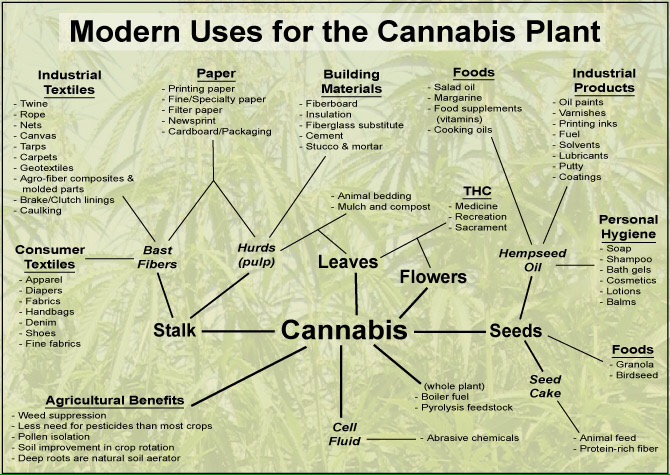Today we struggle with pollution, toxins and chemicals causing countless health and environmental problems. At the same time, our most valuable natural resource – hemp – is illegal. Below are just a few of hemp’s numerous natural benefits. It is easy to see that many large industries, from logging and petroleum to cotton and pharmaceuticals, profit from cannabis prohibition.
Hemp produces 4.5 times more pulp per acre than trees and has a higher quality fiber than wood. Hemp is low in lignin, which means that hemp can be pulped using fewer chemicals than wood. Hemp paper does not turn yellow, is very durable and can be recycled more times. Washington State University produced hemp fiberboard that was found to be twice as strong as wood-based fiberboard. The hemp plant grows quickly to maturity in one short season, where trees take several years.
HEMP PLASTIC
Hempen plastics are biodegradable. They decompose without harming the environment. Petroleum-based plastics, those most common today, ruin nature since they do not readily decompose. The process to produce the vast array of natural hempen plastics will not damage rivers with the toxic runoffs of petrochemical production. Hemp products are stronger, safer and completely natural – benefiting the environment right now and in the future.
HEMP CLOTHING
Extremely strong and durable, hemp clothing can be handed down for generations. Textile products made from hemp are generally better, cheaper, more durable, and ecologically safer. Cotton has a huge environmental impact, as it requires roughly half of the agricultural chemicals used on all U.S. crops. Hemp on the other hand grows well without herbicides, fungicides, or pesticides. Hemp bast fibers are longer, stronger, more absorbent (4x more than cotton), more mildew-resistant, and more insulative than cotton. This means that hemp fabrics keep you warmer in winter and cooler in summer than cotton fabrics.
HEMP FOOD
The hemp seed contains 35% protein, which is more than meat, dairy, fish or poultry. Hemp seeds are longer lasting and more digestible than soybeans. Hemp seeds contain all ten essential amino acids in the correct proportions required by humans, including gamma linoleic acid (GLA), a rare nutrient found in mother’s milk. They are also high in dietary fiber and vitamins B, C and E. Hemp seed oil is one of the richest sources of polyunsaturated fatty acids found in nature. Hemp seeds are a complete source of nutrition – a “super food.”
HEMP MEDICINE
For over 4,000 years, cannabis has been one of the most widely used medicinal herbs. The Atharvaveda, written around the 2nd millennium BC, says it “lowered fevers, fostered sleep, relieved dysentery and cured sundry other ills… stimulated the appetite, prolonged life, quickened the mind and improved judgment.” The American Pharmacopoeia prescribed cannabis for more than 100 separate illnesses or diseases. No less than 80 state and national health care organizations – including the American Public Health Association, American Academy of Family Physicians, American Nurses Association, Leukemia & Lymphoma Society and The New England Journal of Medicine – support immediate, legal patient access to medical cannabis. This support is based upon thousands of patient reports and scores of medical studies.
The primary active ingredient of cannabis: delta-9-tetrahydrocannabinol (THC) was isolated in 1965 by Israeli scientists. Research from 1966-1976 concluded that cannabis is the medicine of choice for glaucoma, epilepsy, muscular spasms, tumor reduction, nausea control in cancer chemotherapy, epilepsy, emphysema, depression, and anorexia nervosa. An excellent dilator of the bronchi and bronchioles of the lungs, cannabis is an herbal alternative treatment for asthma sufferers, including associated chest pains, shallowness of breath, headaches, etc. (Marijuana Pulmonary Research, Tashkin, UCLA, 1969-1983). Scientists at the Scripps Research Institute discovered in 2006 that THC in cannabis inhibits the primary marker of Alzheimer’s disease, and will “treat both the symptoms and progression of the disease” and may even prevent the onset of the disease. FDA-approved medications for Alzheimer’s such as Aricept and Cognex are considerably less effective than cannabis at even twice their prescribed concentration. The chemical beta-caryophyllene contained in cannabis is proven to treat pain, inflammation, atherosclerosis (hardening of the arteries) and osteoporosis (Gertsch, Proceedings of the National Academy of Sciences, June 2008).
Dr. Manuel Guzman won the 2005 Nobel Prize in Physiology and Medicine for his work with cannabis at the Department of Biochemistry and Molecular Biology I, Complutense University in Madrid, Spain. He established the therapeutic value of cannabinoids (the active components of marijuana) in the treatment of melanoma skin cancer, pancreatic cancer, breast cancer, leukemia, brain cancer and virtually all cancerous tumors. Cannabinoids kill cancer cells without harming surrounding healthy cells by blocking vascular endothelial growth factors that provide blood to cancer cells. Furthermore, the neuroprotection provided by cannabis makes it a potential cancer-preventing supplement.
Cannabis is living medicine… a priceless gift to humanity. “And God said, Behold, I have given you every herb bearing seed, which is upon the face of all the earth” (Genesis 1:29, King James Bible).

